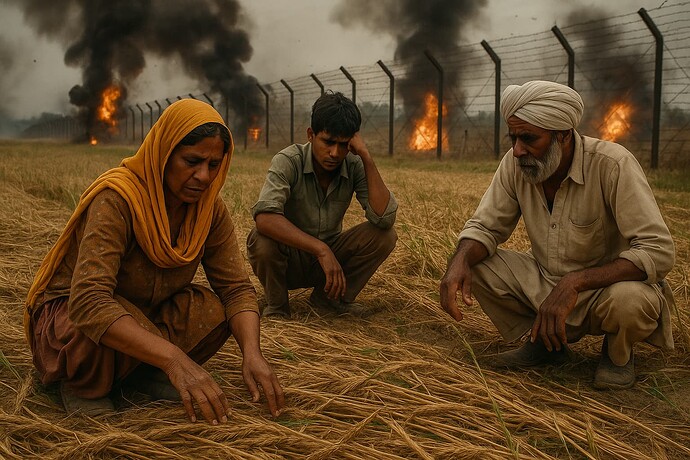Introduction
In April 2025, escalating tensions between India and Pakistan have intensified following a terrorist attack in Jammu & Kashmir. With diplomatic ties worsening and troop movements along the Line of Control (LoC) and International Border, the situation is now being referred to as a “low-intensity war.” While global powers call for restraint, the unfolding conflict is already impacting India’s agrarian communities and broader economy. This report investigates the current and potential consequences of an Indo-Pak war scenario for Indian farmers and the macroeconomic stability of the nation.
1. Border States at Immediate Risk
Farmers in Punjab, Rajasthan, and Jammu & Kashmir—the frontline regions—would be most affected due to:
- Land evacuation near borders: Government orders would require people to vacate farmland within 10–15 km of the Line of Control or International Border for military purposes.
- Damage from shelling: Crop fields, irrigation channels, and tractors may be damaged.
- Restricted movement: Curfews, roadblocks, and deployment of forces would severely limit farmers’ ability to access their fields or mandis.
Example: During the 2016 surgical strikes, over 10,000 farmers near the Punjab border had to leave their villages temporarily, losing the harvest season.
2. Supply Chain & Transport Disruption
- Fertilizer and Seed Delays: War conditions often disrupt rail and road movement of essential agricultural inputs. This could delay sowing, especially in kharif and rabi season windows.
- Interstate movement of produce: Vegetables, grains, and milk from producing states like UP, MP, Maharashtra may face difficulty reaching urban markets.
- Cold storage and mandi operations: Labor may migrate or be unavailable; traders may avoid conflict zones, leading to distress sales or spoilage.
3. Economic & Financial Stress
- Drop in Government Procurement: Focus on defense expenditure could divert funds from MSP procurement, crop insurance, and subsidies.
- Fuel Price Surge: Wars typically spike global crude oil prices. In India, this would increase diesel costs, directly impacting irrigation, tractor use, and transport.
For example, diesel crossing ₹100/litre would push input costs significantly higher. - Inflation in Agri-inputs:
- Imports of fertilizers (like potash) and agri-chemicals could get disrupted.
- Prices may rise by 10–30%, especially for globally sourced inputs.
4. Export Disruption and Price Crash for Some Crops
- Export Blockade: Crops like basmati rice, cotton, spices, and fruits are heavily export-dependent. War risk would:
- Cancel foreign orders (Middle East, Europe).
- Lead to a glut in domestic markets.
- Crash prices by 15–40% for export-linked produce.
- Port Logistics Hit:
- Major ports like Mundra, Kandla, or Mumbai could be affected, stalling agri-exports and imports.
5. Crop Insurance and Credit Stress
- Crop damage due to shelling or movement restrictions may not be covered under current PMFBY policies unless reclassified under ‘war loss’.
- Credit Cycle Broken:
- Banks may slow fresh agri-loan disbursements due to national risk.
- Loan repayment stress would increase due to low income from unsold or damaged crops.
6. Labor Shortage in Agriculture
- Reverse migration of farm workers may occur in high-risk zones.
- Military recruitment drives or conscription-type models could absorb young rural men, reducing farm labor availability.
- Wage rates could rise by 20–30% in interior states due to shortfall.
7. Mental Health & Social Impact on Farmer Families
- Increased uncertainty, panic, and food security fears in rural families.
- School closures, migration, and family separation in border belts may affect rural children, especially those already living in poverty.
- Farmers may delay farm investments due to fear of destruction or non-returns.
8. Government Support: Likely Emergency Measures
If war occurs, the government may:
- Announce special compensation for border farmers.
- Stockpile food grains through emergency procurement at MSP.
- Expand PM-KISAN payouts temporarily.
- Freeze or lower input prices using extra subsidies on urea/diesel.
- Set up mobile mandis or relief camps in conflict-hit zones.
But execution would depend on the duration and intensity of the conflict.
Conclusion
An India–Pakistan war in 2025 would have severe localized impacts in frontline states and economic ripple effects across India’s entire agricultural value chain. While Indian farmers are resilient, a prolonged conflict could derail crop cycles, income security, food prices, and rural peace. Ensuring early evacuation plans, emergency procurement, and safeguarding supply chains must be part of contingency planning to protect India’s food producers.
Recommendations
| Focus Area | Action Steps |
|---|---|
| Border Area Protection | Pre-identify evacuation zones and compensate farmers for crop loss. |
| Input Supply Chain | Prioritize movement of fertilizers, diesel, and seeds during conflict. |
| Economic Relief | Provide war-zone bonus, temporary MSP hikes, and fast-track insurance claims. |
| Export Management | Diversify agri-export destinations and maintain buffer stocks. |
| Credit & Liquidity | Defer loan EMIs, increase KCC limits in affected areas. |
| Mental Health | Set up helplines and rural counseling in conflict-prone regions. |
Prepared by: Famalth Research Desk (30 April 2025)
